Family : Syngnathidae

Text © Giuseppe Mazza

English translation by Mario Beltramini
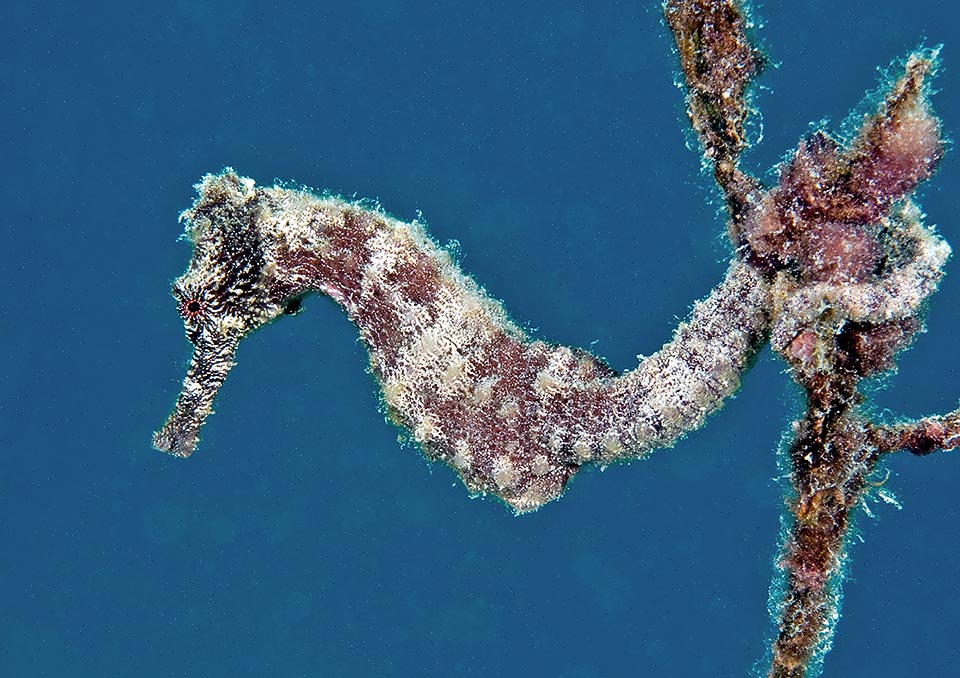
Hippocampus reidi has a vast range of western Atlantic, from North Carolina to the Gulf of Mexico, the Caribbean Sea and South America up to southern Brazil © Terence Zahner
The Longsnout seahorse (Hippocampus reidi Ginsburg, 1933) is a colourful master of camouflage.
Because of its tiny fins, like all seahorses it is a very bad swimmer, but by changing colours and patterns depending on the circumstances, it blends in with the environment for hunting in ambush and not drawing too much attention to the predators.
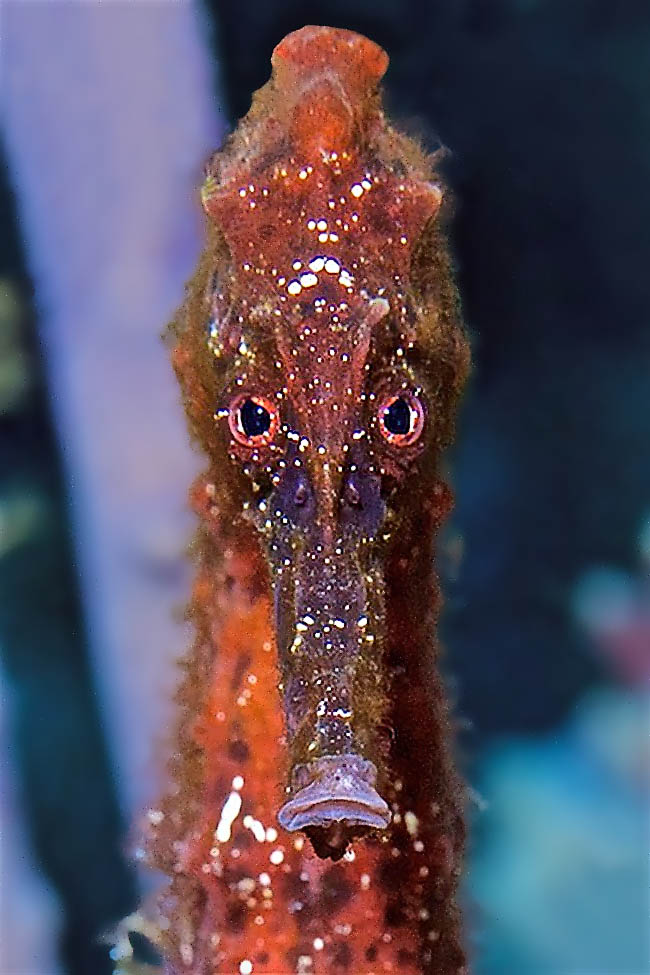
Known as Longsnout seahorse, it has the eyes moving independently, like the chameleons. They look for the preys and then in frontal position, with a perfect stereoscopic vision, they evaluate well the distances to center them © Allison & Carlos Estape
It belongs to the Actinopterygii, the class of ray-finned fishes, to the order Syngnathiformes and to the family of the Syngnathidae, that of the pipefishes and of the seahorses, that, after the “Eschmeyer’s Catalog of Fishes” presently counts 59 genera and 307 species.
The genus Hippocampus originates from the old Greek “ἵππος” (hippós), horse, and “κλίσις” (kampé), curvature, with allusion to the head bent almost at a right angle to the body.
The specific term reidi, of Reidi in Latin, recalls Earl D. Reid (1885-1960), scientific assistant in the fish division and later associated curator of the fishes at the National Museum of the United States where Ginsburg worked.
Zoogeography
Hippocampus reidi is present in the coastal waters of western Atlantic, from North Carolina to the Gulf of Mexico, the Caribbean Sea and South America up to southern Brazil.
Ecology-Habitat
It also accepts brackish waters and does never exceed the depth of 55-60 m.
In the Brazilian estuaries it is even frequent in less than 40 cm of water.
It is often found among the corals clinging to the gorgonians with its tail or hidden behind the ramifications of the so-called “rope sponges”, the colourful ‘erect rope sponges”, like Niphates erecta or Amphimedon compressa, that perfectly imitates in the details.
It frequents the phanerogams prairies, the macroalgae of the genera Penicillus and Caulerpa, without neglecting the formations of mangroves such as Avicennia shaueriana, Rhizophora mangle or Laguncularia
racemosa, rich in food and in aerial roots that offer easy grips, but can be found also stuck to drifting floating algae like the sargassoes.
Morphophysiology
Hippocampus reidi usually reaches the length of 10 cm (15 with tail stretched out) with a record to 15,5 cm.
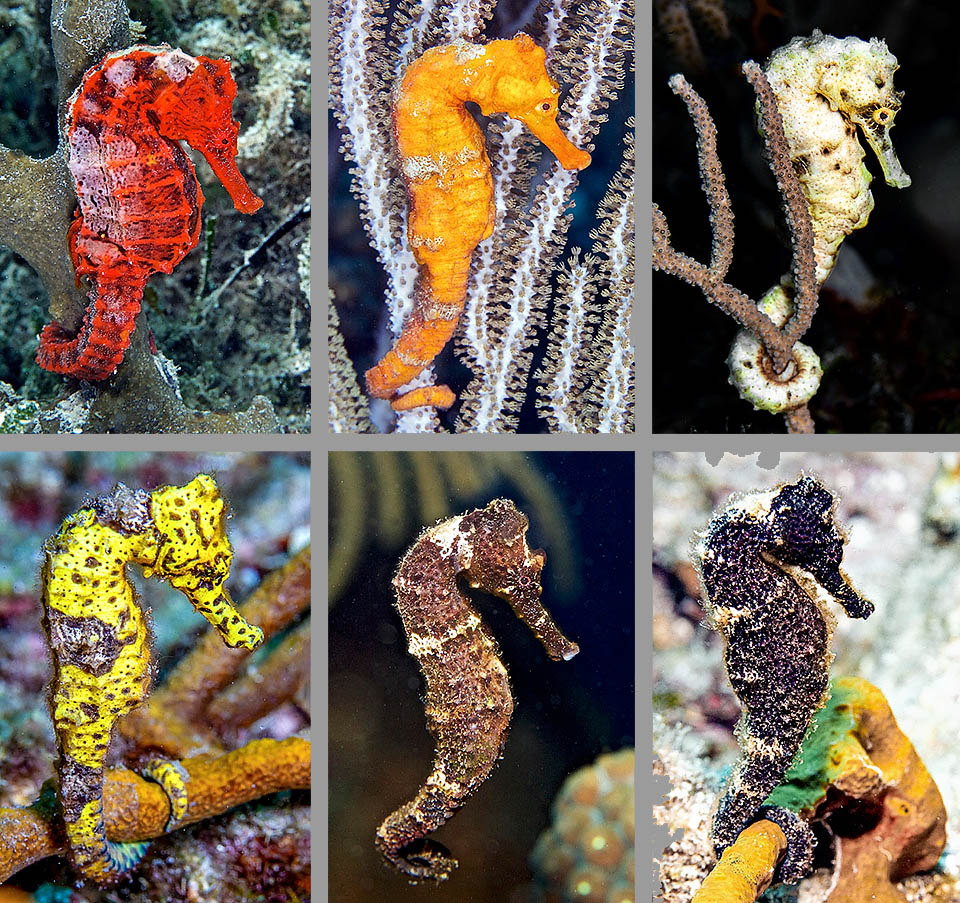
Usually about ten centimetres long, has ready, memorized, various models of colour and brightness, to quickly adapt the livery to the environments where it lives © Allison & Carlos Estape
It is protected by an armour of bony plates, called due to their shape rings: 11 on the body and 35 (31-39) for the trunk that ends in a prehensile tail.
The males display a showy brood pouch for the eggs that extends per 5-7 rings on the ventral side.
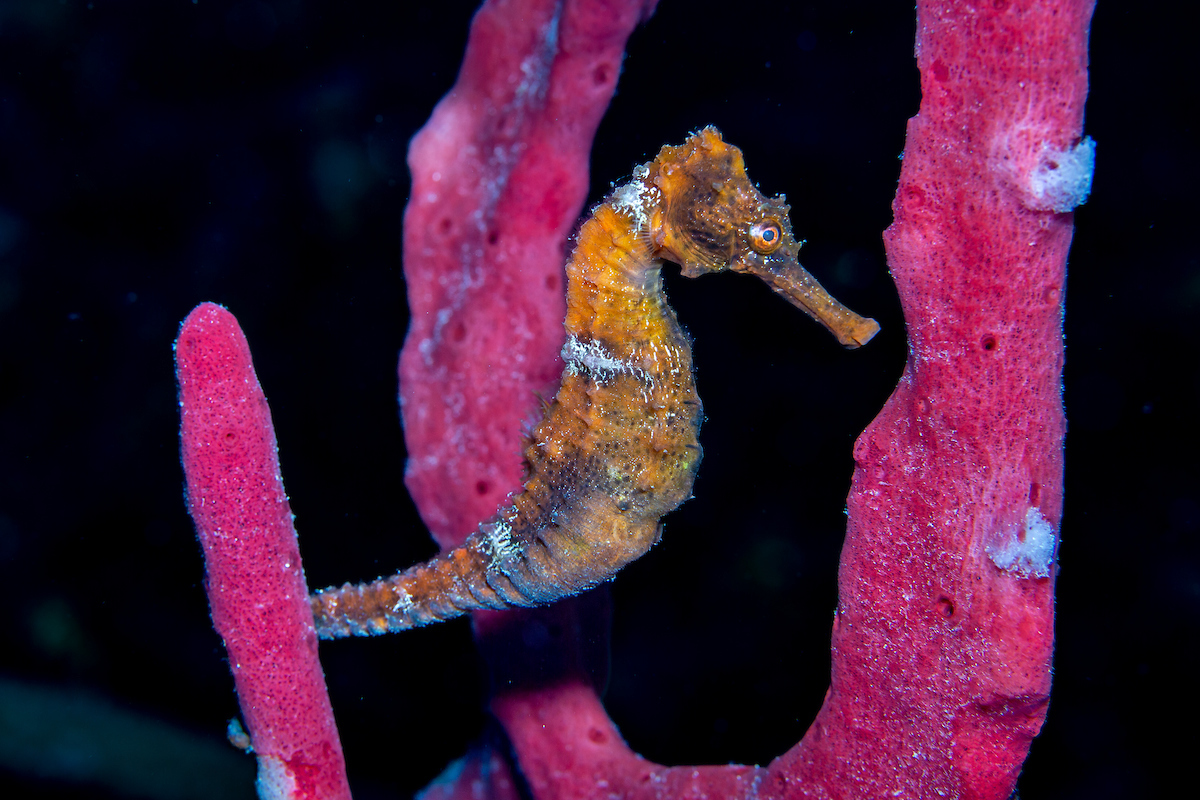
Here, clinging to a rope sponge (Amphimedon compressa) even imitates its details, acting on the colour of its dorsolateral bands © Allison & Carlos Estape
The crown, typical of the seahorses, usually formed by sharp bony protuberances located at the top of the head, here has no spines but is replaced by skin outgrowths, flat or twisted, rounded at the apex like the tubercles.
Apart from the two small ocular spines, the armour appears consequently smooth, without defensive asperities.
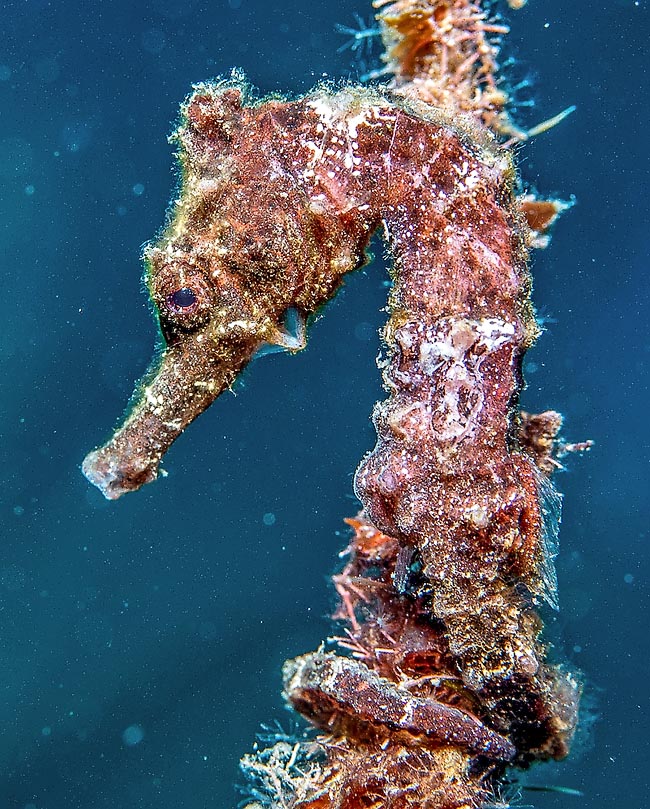
In the seahorses world Hippocampus reidi is decidedly a master in mimicry. Here it has shown off its brown livery, eliminating completely the clear dorsoventral bands, and redoes meticulously the drawings of the support © Allison & Carlos Estape
In fact, as we have seen, this seahorse does not need them, because its chromatophores may, with various stored patterns of colour and brightness, quickly adapt the livery to the environments where it lives.
It may present white, yellow, red, orange, brown or black with several white or black small dots and often are present some dorsolateral light saddles that break the contour of the body.
The snout, as the vulgar name states, is long and large: a sort of pipette for aspirating entire microscopic shrimps and amphipods, and suck in on the fly the zooplankton passing by close, mainly eggs of fishes, copepods and ostracods, its has been observed also chasing its prey.
Like the chameleons, the eyes move independently of each other.
They search for prey in every direction and then, in frontal position for a perfect stereoscopic vision, evaluate with precision the distances to centre them.
During the daylight hours Hippocampus reidi feeds almost continuously, because the seahorses do not have a stomach and their rapid intestinal digestion is poorly efficient.
By night it rests, wrapping its tail around a support, and when the dawn comes again, it resumes the hunt by swimming vertically with fast oscillations of its 17 (16-19) rays of the dorsal fin and the 16 (15-17) of the pectoral ones.
The anal fin is very small, and the pelvic fins and the caudal are absent.
Ethology-Reproductive Biology
Hippocampus reidi is found usually solitary or in couples but more rarely also in small schools of up to 7 individuals.
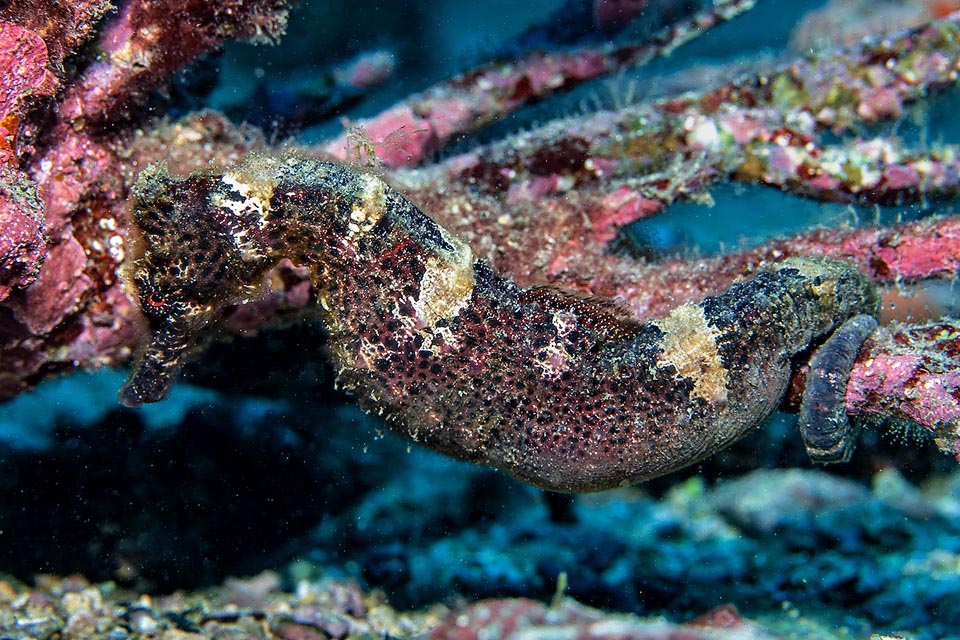
Well done to anyone who can spot it in this stunning image! Its mimetic ability is such that it can do without the defensive spines usually present in the seahorses © Allison & Carlos Estape
It can live up to 4 years. The sexual maturity begins around the eight months of age, when about 8,8 cm long for the females and 9,5 cm for the males, who usually have a smaller hunting territory due to the less mobility imposed by the brood pouch.
The reproductive season, with different peaks depending on the zones, lasts at least 8 months per year.
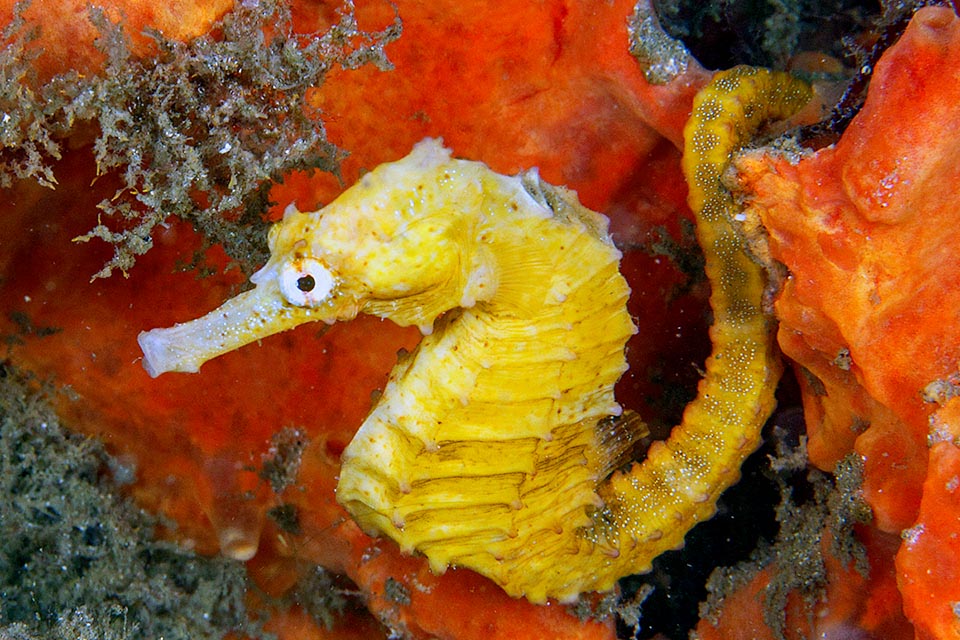
In fact the body of this female, appears smooth, protected by an armour of bony plates with blunt tips, called, seen their shape, rings © Kevin Bryant
The male courts its partner for a long time, impressing it with showy changes in colour and swimming around it shows on several occasions the pouch swollen with water intended to accommodate the eggs.
These, oval or pear shaped, with a diameter of 1,2 mm are orange and when the moment has come, the male empties the brood pouch pressing it with its tail, whilst the female gets closer and introduces the ovules by means of the genital papilla, a sort of a few millimetres ovipositor.
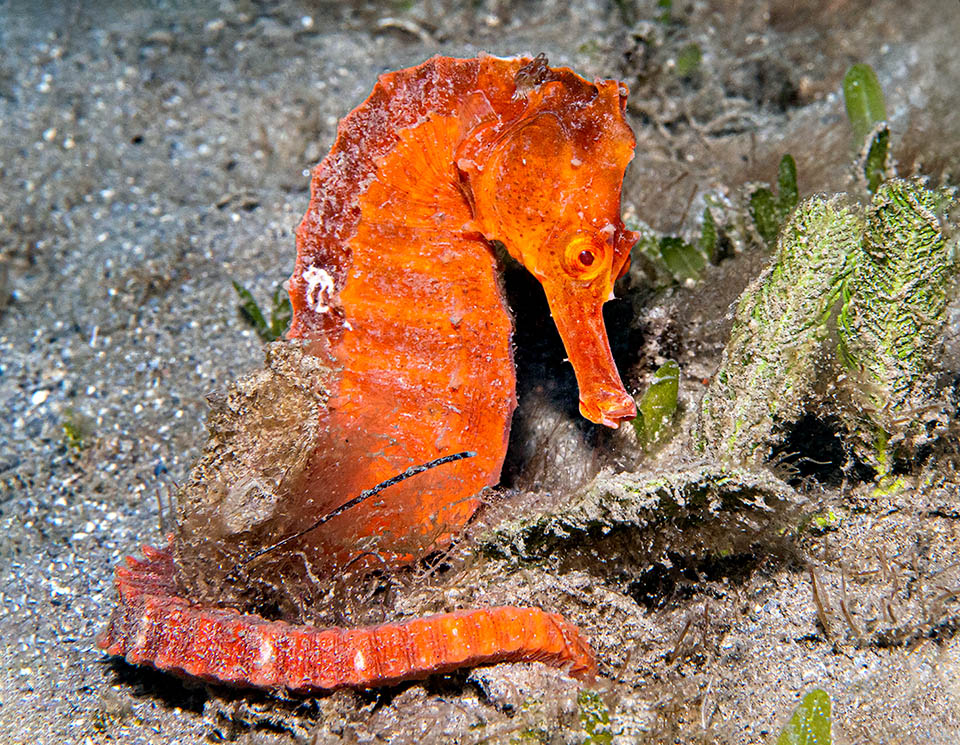
Like all seahorses Hippocampus reidi is an ovoviviparous species and the males have ventrally a pouch for the incubation of the eggs © Brian Cole
Hence the fecundation takes place in the father’s pouch where the eggs, in addition to the nutrition of the yolk, get oxygen and food from the male’s capillaries.
The pouch is sealed and the incubation, depending on the water temperature, lasts about two weeks. At the end it’s the male who has the contractions and the babies are expelled repeatedly, rolled up in a ring.
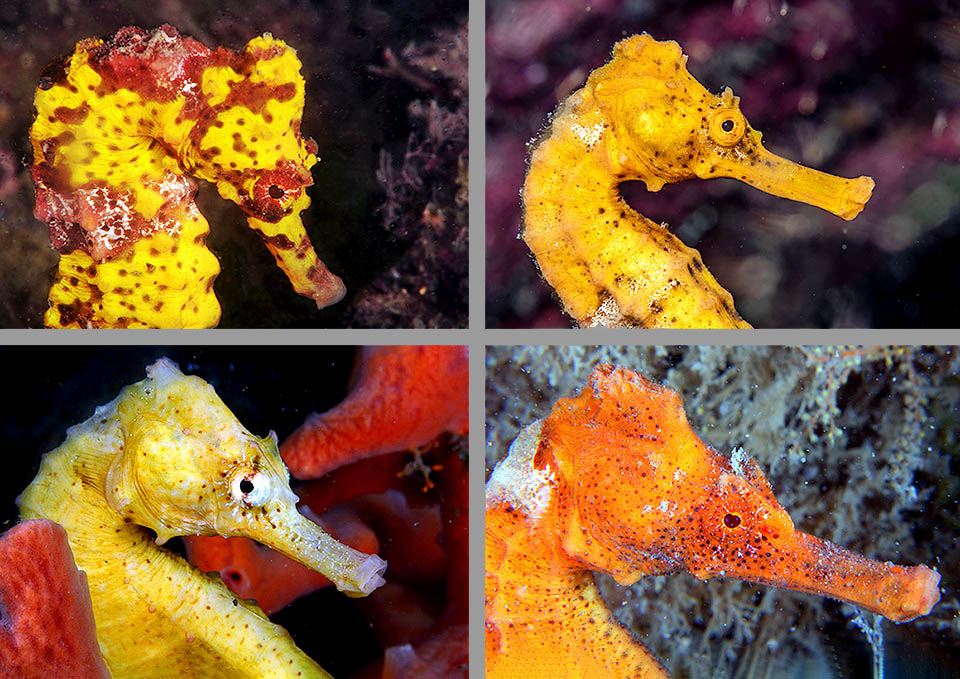
The seahorse’s crown, formed by bony structures pointed at the top of the head, here arises from flat or twisted extensions of the skin and we note only the 2 ocular spines. Up © Alexandre Ornellas and © Allison & Carlos Estape – Below © Kevin Bryant
They stretch out at once, completely autonomous and similar to their parents, just 5-7 mm long.
It has been noted that the males with the eggs are less active than the others and that, for recovering and facing a new pregnancy, they need about seven months.
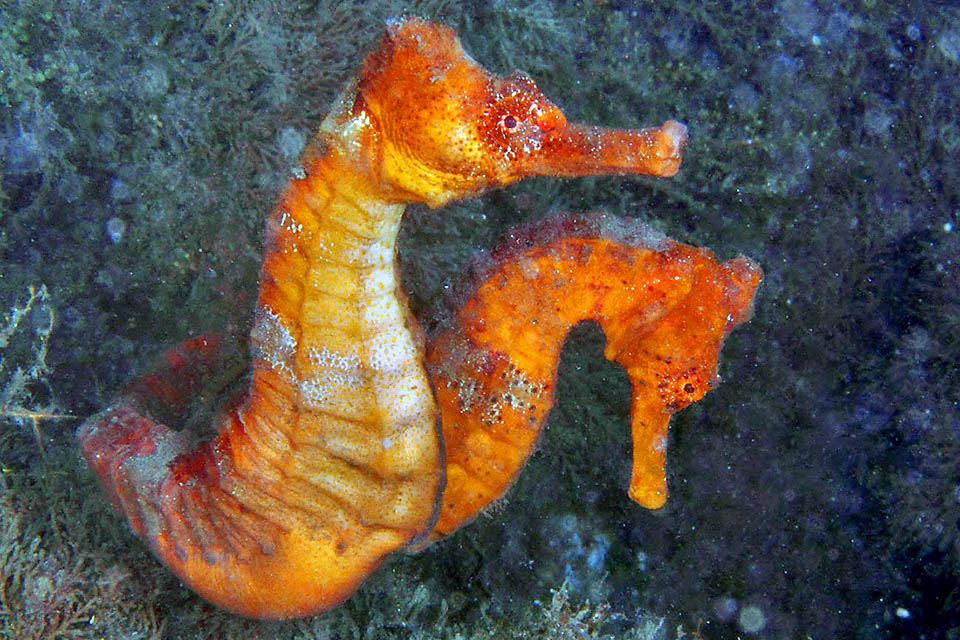
Hippocampus reidi is a monogamous species and even after the long courting it is often found in couple © Kevin Bryant
The resilience of the species is mediocre, with a minimum time for doubling the populations of 1,4-4,4 years and the fishing vulnerability, decidedly low, marks only 12 on a scale of 100 as it is a fish that only occasionally falls into the trawl nets.
However, Hippocampus reidi appears as “NT, Near Threatened” in the IUCN Red List of the endangered species. As a matter of fact, even if in certain areas like the Gulf of Mexico the populations are stable, the Longsnout horse has lost more than the 30% of its membres in most of the range and there is someone talking of a possible decrease of the 90% in various sites within a decade.
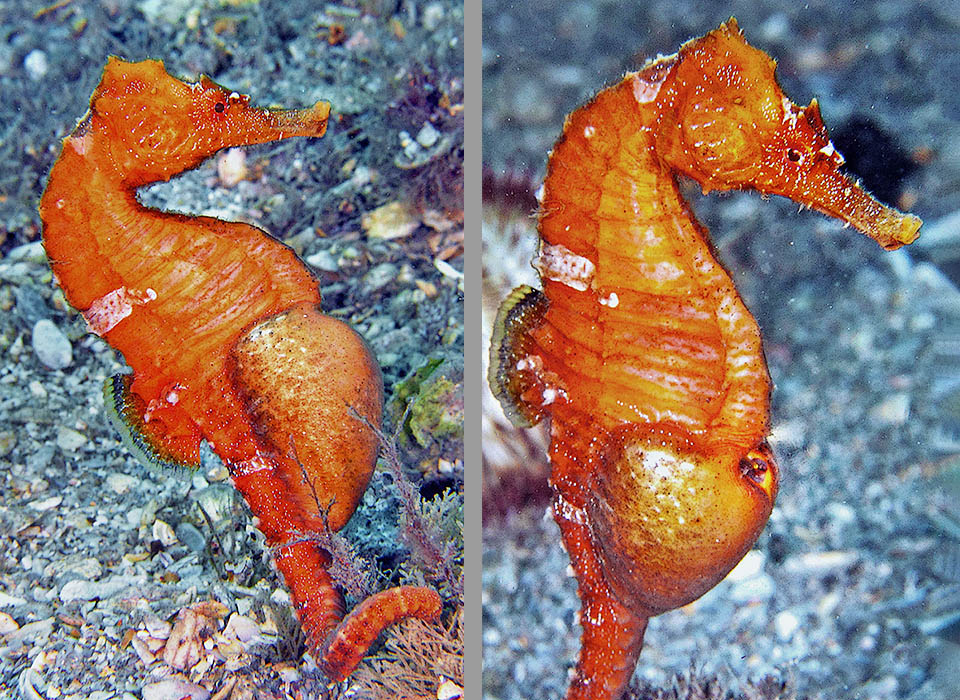
Male with its showy pouch full with babies. Right, the delivery contractions have already started and we see a baby getting out ring-folded © Kevin Bryant
But more than accidental capture with the nets, more than the natural predators like the red snappers, the rays, the tunas and the common dolphin fishes, without forgetting the parasites, the Longsnout sea horse is nowadays threatened by the man due to the pollution caused by the oil platforms, the waste waters from the houses and the reshaping of the coasts with often the loss of its habitat of mangroves, corals and submerged prairies.
Plus, cute as it is and easy to catch, it stands among the most frequent fishes in the marine aquaria where, if well kept, it may even reproduce.
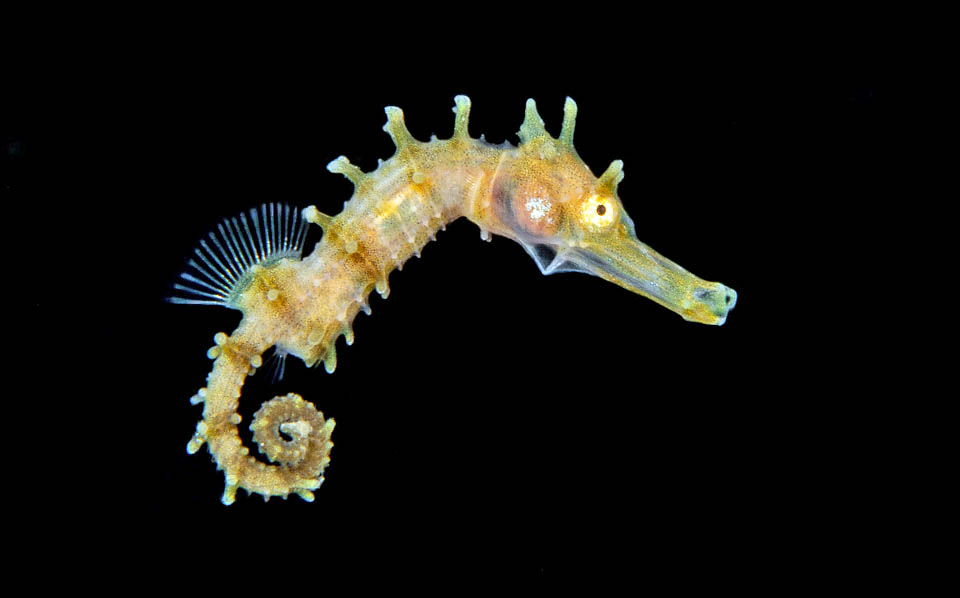
Since their birth, when they measure 5-7 mm, the little Hippocampus reidi are completely independent and similar to parents and have a lifespan of about 4 years © Linda Ianniello
Between 2010 and 2014 the CITES, that controls the international trade of the endangered species, has recorded the export of 10.000 specimens per year, not to talk about the internal and illegal trades. They are paid just a little over one US Dollar to those who catch them and resold at 10-12 US Dollars.
Moreover, there is the market of the dried Hippocampus reidi, purchased by the tourists as souvenirs, key rings, or as knick-knacks, created with shells, corals and starfishes.
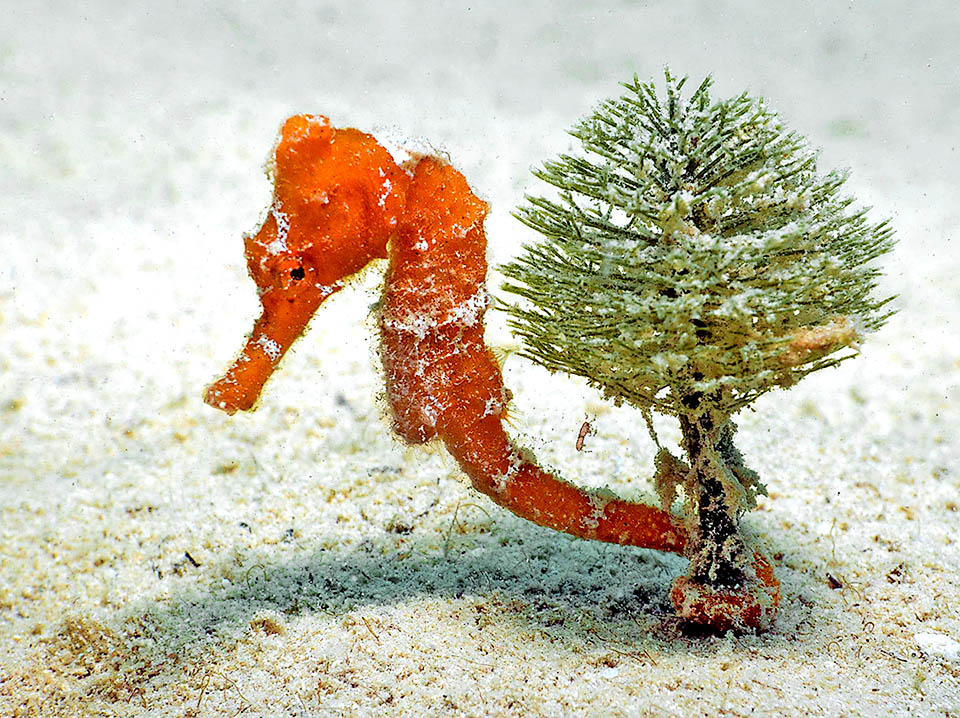
Juvenile attached to a Penicillus dumetosus. Threatened by human activities, Hippocampus reidi appears “NT, Near Threatened” in IUCN Red List of endangered species © Mickey Charteris
In Brazil they are also worn hanging around the neck against the evil eye or kept in the pocket as lucky charms locally called “pautás” and are sold pulverized in Asia for alleged medicinal virtues that should cure baldness and about 30 diseases such as gastritis, asthma, bronchitis and tuberculosis.
Synonyms
Hippocampus obtusus Ginsburg, 1933; Hippocampus poeyi Howell Rivero, 1934.
→ For general information about FISH please click here.
→ For general information about BONY FISH please click here
→ For general information about CARTILAGINOUS FISH please click here.
→ To appreciate the BIODIVERSITY of BONY FISH please click here.
→ To appreciate the BIODIVERSITY of CARTILAGINOUS FISH please click here.
